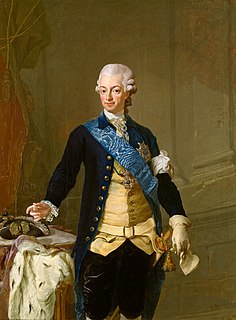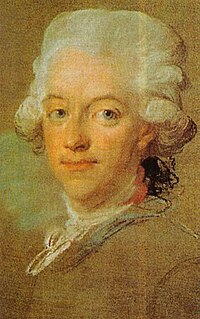 W
WThe History of Sweden from 1772 through 1809 is better known as the Gustavian era of Kings Gustav III and Gustav IV, as well as the reign of King Charles XIII of Sweden.
 W
WThe History of Sweden from 1772 through 1809 is better known as the Gustavian era of Kings Gustav III and Gustav IV, as well as the reign of King Charles XIII of Sweden.
 W
WGustav III was King of Sweden from 1771 until his assassination in 1792. He was the eldest son of Adolf Frederick, King of Sweden and Queen Louise Ulrika, and a first cousin of Empress Catherine the Great of Russia by reason of their common descent from Christian August of Holstein-Gottorp, Prince of Eutin, and his wife Albertina Frederica of Baden-Durlach.
 W
WThe 1789 Conspiracy was a plot in Sweden in 1789, with the purpose of deposing Gustav III of Sweden, and place his brother Charles XIII of Sweden on the throne. The plot was instigated by a group of consirators at the royal court, consisting of among others the king's sister-in-law, Charles' spouse Hedvig Elisabeth Charlotte of Holstein-Gottorp, the king's youngest brother Prince Frederick Adolf, Duke of Östergötland, and Charles' favorite Gustaf Adolf Reuterholm. The plot was influenced by the opposition of the nobility against Gustav III because of the Union and Security Act during the Russo-Swedish War (1788–1790), and the plan was to convince Charles to act as the central figure and symbol of this opposition. The plot was discontinued because Charles, when informed, refused to participate in it. The plot was never officially exposed and did not result in any legal action.
 W
WThe Anjala conspiracy of 1788 was a scheme by disgruntled Swedish officers to end Gustav III's Russian War of 1788–90. Declaring Finland an independent state was not a part of the original plot, but one of the conspirators Johan Anders Jägerhorn, who handed the note to Empress Catherine the Great, made such claims in Saint Petersburg.
 W
WThe Armfelt Conspiracy was a plot in Sweden in 1793. The purpose was to depose the de jure regent Duke Charles and the de facto regent Gustaf Adolf Reuterholm, leaders of the regency government of Gustav IV Adolf of Sweden, and replace them with Gustaf Mauritz Armfelt, the favorite of the king's father Gustav III of Sweden. The plot was instigated by the exiled Armfelt and handled by his agents in Sweden, notably his lover Magdalena Rudenschöld, with support of the Russian Empire under Catherine the Great. The conspiracy was exposed in 1793.
 W
WGustav III was King of Sweden from 1771 until his assassination in 1792. He was the eldest son of Adolf Frederick, King of Sweden and Queen Louise Ulrika, and a first cousin of Empress Catherine the Great of Russia by reason of their common descent from Christian August of Holstein-Gottorp, Prince of Eutin, and his wife Albertina Frederica of Baden-Durlach.
 W
WSweden's Constitution of 1772 took effect through a bloodless coup d'état, the Revolution of 1772, carried out by Gustav III, who had become king in 1771. It established once again a division of power between the parliament and the king. The period came to be known as the Gustavian era. This was a response to a perceived harm wrought upon Sweden by a half-century of parliamentarism during the country's Age of Liberty practiced according to the Instrument of Government (1719), as many members of the Swedish parliament then used to be bribed by foreign powers.
 W
WThe Dano-Swedish War of 1808–1809 was a war between Denmark–Norway and Sweden due to Denmark–Norway's alliance with France and Sweden's alliance with the United Kingdom during the Napoleonic Wars. Neither Sweden nor Denmark-Norway had wanted war to begin with but once pushed into it through their respective alliances, Sweden made a bid to acquire Norway by way of invasion while Denmark-Norway made ill-fated attempts to reconquer territories lost to Sweden in the 17th century. Peace was concluded on grounds of status quo ante bellum on 10 December 1809.
 W
WThe French Theater of Gustav III was a French language theater active in Sweden between 1781 and 1792. The French theater company performed both before the Swedish royal court in the theaters of the royal palaces, as well as before the Swedish public in Stockholm. It is known to have played a significant part in the education of the pioneer generation of actors at the Royal Dramatic Theatre.
 W
WThe funeral of King Gustav III of Sweden took place on 14 May 1792. The king had died on 29 March as a result of the injuries he sustained when he was shot by Jacob Johan Anckarström during a masquerade ball at the Royal Opera in Stockholm on 16 March.
 W
WGustav III of Sweden's coffee experiment was a twin study ordered by the king to study the health effects of coffee. Although the authenticity of the event has been questioned, the experiment, which was conducted in the second half of the 18th century, failed to prove that coffee was a dangerous beverage.
 W
WNationella dräkten is a historic Swedish costume, designed by King Gustav III and introduced in 1778. It was designed for the nobility and the middle class with the intention of limiting rising consumption and import of luxury within fashion, which was considered a drain on the economy and detrimental to society because of ensuing poverty. A masculine and a feminine costume were designed. The woman's version of the costume was to have a lasting effect, modified several times later, as the official costume of the Royal Court.
 W
WThe Revolution of 1772, also known as the Coup of Gustav III was a Swedish coup d'état performed by king Gustav III of Sweden on 19 August 1772 to introduce absolute monarchy against the Riksdag of the Estates, resulting in the end of the Age of liberty and the introduction of the Swedish Constitution of 1772.
 W
WThe Russo-Swedish War of 1788–1790, known as Gustav III's Russian War in Sweden, Gustav III's War in Finland and Catherine II's Swedish War in Russia, was fought between Sweden and Russia from June 1788 to August 1790.